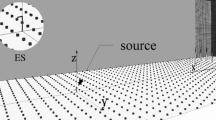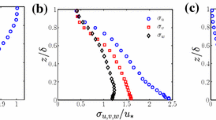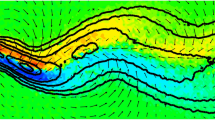Abstract
We investigate the reliability of a meandering plume model in reproducing the passive scalar concentration statistics due to a continuous release in a turbulent boundary layer. More specifically, we aim to verify the physical consistency of the parametrizations adopted in the model through a systematic comparison with experimental data. In order to perform this verification, we take advantage of the velocity and concentration measurements presented in part I of the present study (Nironi et al., Boundary-Layer Meteorol, 2015) particularly concerning estimates of the Eulerian integral length scales and the higher order moments of the concentration probability density function. The study is completed by a sensitivity analysis in order to estimate the effects of the variations of the key parameter to the model results. In the light of these results, we discuss the benefits and shortcomings of this modelling approach and its suitability for operational purposes.











Similar content being viewed by others
References
Amicarelli A, Salizzoni P, Leuzzi G, Monti P, Soulhac L, Cierco FX, Leboeuf F (2012) Sensitivity analysis of a concentration fluctuation model to dissipation rate estimates. Int J Environ Pollut 48:164–173
Arya PS (1999) Air pollution meteorology and dispersion. Oxford University Press, Oxford, 310 pp
Biferale L, Boffetta G, Celani A, Devenish BJ, Lanotte A, Toschi F (2005) Lagrangian statistics of particle pairs in homogeneous isotropic turbulence. Phys Fluids 17:115101/1–115101/9
Boffetta G, Sokolov I (2002) Relative dispersion in fully developed turbulence: the Richardson’s law and intermittency corrections. Phys Lett 88:094501/1–094501/4
Cassiani M (2013) The volumetric particle approach for concentration fluctuations and chemical reactions in Lagrangian particle and particle-grid models. Boundary-Layer Meterol 146:207–233
Cassiani M, Franzese P, Giostra U (2005) A PDF micromixing model of dispersion for atmospheric flow. Part I: Development of the model, application to homogeneous turbulence and neutral boundary layer. Atmos Environ 39:1457–1469
Cassiani M, Giostra U (2002) A simple and fast model to compute concentration moments in a convective boundary layer. Atmos Environ 36:4717–4724
Fackrell JE, Robins AG (1982) The effects of source size on concentration fluctuations in plumes. Boundary-Layer Meteorol 22:335–350
Ferrero E, Mortarini L, Alessandrini S, Lacagnina C (2013) Application of a bivariate gamma distribution for a chemically reacting plume in the atmosphere. Boundary-Layer Meteorol 147:123–137
Franzese P (2003) Lagrangian stochastic modeling of a fluctuating plume in the convective boundary layer. Atmos Environ 37:1691–1701
Franzese P, Cassiani M (2007) A statistical theory of turbulent relative dispersion. J Fluid Mech 571:391–417
Gailis RM, Hill A, Yee E, Hilderman T (2007) Extension of a fluctuating plume model of tracer dispersion to a sheared boundary layer and to a large array of obstacles. Boundary-Layer Meterol 607:577–607
Gifford F (1959) Statistical properties of a fluctuating plume dispersion model. Adv Geophys 6:117–137
Ishihara T, Kaneda Y (2002) Relative diffusion of a pair of fluid particles in the inertial subrange of turbulence. Phys Fluids 14:L69–L72
Leuzzi G, Amicarelli A, Monti P, Thomson DJ (2012) A 3D Lagrangian micromixing dispersion model LAGFLUM and its validation with a wind tunnel experiment. Atmos Environ 54:117–126
Luhar AK, Hibberd MF, Borgas MS (2000) A skewed meandering plume model for concentration statistics in the convective boundary layer. Atmos Environ 34:3599–3616
Monin AS, Yaglom AM (1971) Statistical fluid mechanics, vol 1. MIT Press, Cambridge, 769 pp
Mortarini L, Franzese P, Ferrero E (2009) A fluctuating plume model for concentration fluctuations in a plant canopy. Atmos Environ 43:921–927
Nironi C, Salizzoni P, Marro M, Mejan P, Grosjean N, Soulhac L (2015) Dispersion of a passive scalar fluctuating plume in a turbulent boundary layer. Part I: Velocity and concentration measurements. Boundary-Layer Meteorol
Obukhov AM (1941) On the distribution of energy in the spectrum of turbulent flow. Izv Akad Nauk USSR, Ser Geogr Geofiz 5:453–466
Ott S, Mann J (2000) An experimental investigation of the relative diffusion of particle pairs in three-dimensional turbulent flow. J Fluid Mech 422:207–223
Reynolds AM (2000) Representation of internal plume structure in Gifford’s meandering plume model. Atmos Environ 34:2539–2545
Richardson LF (1926) Atmospheric diffusion shown on a distance-neighbour graph. Proc R Soc Lond 110:709–737
Sawford B (2004) Micro-mixing modelling of scalar fluctuations for plumes in homogeneous turbulence. Flow Turbul Combust 72:133–160
Sawford B, Stapountzis H (1986) Concentration fluctuations according to fluctuating plume models in one and two dimensions. Boundary-Layer Meteorol 37:89–105
Tennekes H (1982) Similarity relations, scaling laws and spectral dynamics. In: Niewstadt F, Van Dop H (eds) Atmospheric turbulence and air pollution modelling. D. Reidel Publishing Company, Dordrecht, pp 37–68
Vinkovic I, Aguirre C, Simoëns S (2006) Large-eddy simulation and Lagrangian stochastic modeling of passive scalar dispersion in a turbulent boundary layer. J Turbul 7:1–14
Xie Z, Hayden P, Voke PR, Robins AG (2004) Large-eddy simulations of dispersion: comparison between elevated and ground level sources. J Turbul 5:1–16
Yee E, Chan R, Kosteniuk PR, Chandler GM, Biltoft CA, Bowers JF (1994) Incorporation of internal fluctuations in a meandering plume model of concentration fluctuations. Boundary-Layer Meteorol 67:11–39
Yee E, Wilson DJ (2000) A comparison of the detailed structure in dispersing tracer plumes measured in grid-generated turbulence with a meandering plume model incorporating internal fluctuations. Boundary-Layer Meteorol 94:253–296
Author information
Authors and Affiliations
Corresponding author
Rights and permissions
About this article
Cite this article
Marro, M., Nironi, C., Salizzoni, P. et al. Dispersion of a Passive Scalar Fluctuating Plume in a Turbulent Boundary Layer. Part II: Analytical Modelling. Boundary-Layer Meteorol 156, 447–469 (2015). https://doi.org/10.1007/s10546-015-0041-9
Received:
Accepted:
Published:
Issue Date:
DOI: https://doi.org/10.1007/s10546-015-0041-9




